This page covers the mapping techniques to use for private installations and for neighborhoods that have restricted access of some kind.
Introduction
Problem Definition

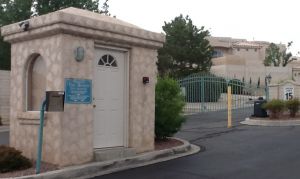
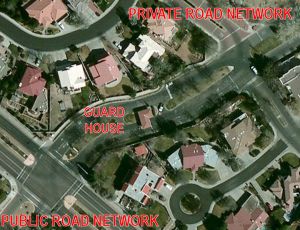
A Private Installation or Community is a small to large restricted-access set of regularly navigable roads connected at one or more points to a public road network. The smallest example may be a single private community street protected by a gate. The largest USA installation is White Sands Missile Range at 3,200 square miles, larger than the USA’s smallest state, which includes dirt roads, primary streets and highways. Waze should be able to provide the best route for everyone. We wish to address such locations because many "resident" drivers work and live within private installations. Some "visitors" may be handled differently. Above all, we must prevent erroneous routes through private installations for those who do not have or need access, as it causes a significant inconvenience.
Actual access restriction in these installations or communities is usually implemented by automated gates or guards that only allow entry by authorized individuals or vehicles. In more rare cases, gates may be controlled with a mechanical lock of some kind. An unmanned means of preventing one-way access could be tire puncture strips that would deflate tires of vehicles going in one direction. In some cases access may be unrestricted by physical means, but may be implemented through patrols, cameras, or other means that would lead to a response to apprehend an unauthorized visitor.
A Private Installation, particularly larger government facilities, may have nested levels of access control. A particular region of the installation may be excluded to those who have general access to the larger installation. Larger examples may have all types of roads such as primary streets and highways. Smaller examples would only have roads and dirt roads.
While many Private Installations are easy to map in Waze, some can be rather complex in how we represent access points, create road types, and use Places. Because of this complexity, this wiki page is fairly lengthy. If you're a new editor, it is suggested you seek advice from others before editing anything but the smallest and most simple Private Installations.
Terminology
Access Point - Any entry or exit (usually both together) that connects the Private Installation road network with the public road network. See Gate.
Gate - A specific type of "Access Point" that connects the Private Installation road network with the public road network. There are multiple types of gate structures that can be edited for any access point.
Majority Drivers - The type of driver that most frequently accesses the Private Installation. This could be a resident or a visitor. For instance one might say "Visitors are Majority Drivers on this Private Installation."
Minority Drivers - All types of drivers that also may access the Private Installation, but in amounts that are significantly less than Majority Drivers.
Public - The set of drivers who have no business entering the Private Installation. They should remain on the public road network.
Resident - A driver who lives, works, or has some other regular and authorized access to the private installation. This may include public transportation.
Visitor - A driver who has some business accessing the private installation, but not on a regular basis. These people may need to use special entrances to the private installation. Visitors can act like Residents if they eventually obtain access credentials (code, badge, pass, etc.).
Editing Objectives
Before you edit or modify a Private Installation, consider these six objectives you have as a map editor for private installations.
- Make sure to route around, on, off, but never through
- Realize a diversity of installations exists
- Consider how Resident & Visitors are handled
- Make sure to consider exceptions: Installations with Special Rules
- Protect your private installation editing from novice editors
- Test your private installation
Routing Around, On, Off, But Never Through
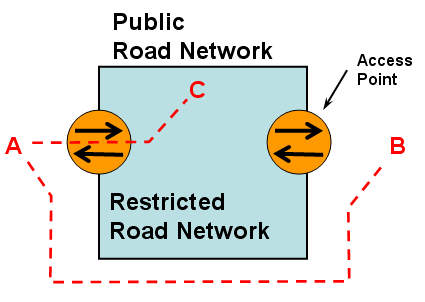
Waze should not automatically route onto or through a private installation unless the source or destination point is within the installation. Figure 1 shows the general concept of a private installation which is embedded in a public road network. In this case there are two access points. Waze should route around the private installation from A to B even though a shorter or faster route might exist through the installation. Waze should also be able to route from A to C or C to A, where C is located within the private installation. Note that Waze should also not use roads within a Private Installation as a convenience to turn around a driver when avoiding u-turns.
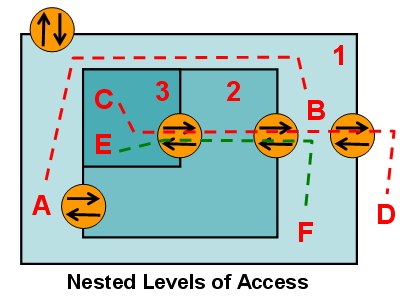
Figure 2 shows that some, usually larger, private installations may have nested levels of access. Waze should be able to route on or off of a private installation at any level of nested access without entering a separate access area of a deeper level. Route A to B illustrates this concept. Additionally, Waze should be able to navigate from a deeper level of nested access to any other point including off the private installation. Routes between points C and D illustrates routing onto or off of the private installation. Routes between points E to F shows navigation between nested levels. Waze should also be able to navigate well within a larger installation that has multiple road types.
Diversity of Installations Exists
There are many types of Private Installations that can represent a large variation on types of access points, gates, and routing preference for residents and guests. While most Private Installations are the same and follow a "Simple" approach, those that design and build special entrances and exits may come up with something new for which the editor will have to adapt.
Attempt to keep your map design simple!
Consider Resident & Visitors
This is a more advanced concept. If you do not understand these issues or cannot identify how your Private Installation deals with Visitors differently from Residents, you may wish to follow the preferred approaches or seek help from others with more experience.
Why is resident versus visitor an issue?
The easy answer is that some Private Installations have gates that serve only residents while others serve both visitors and residents. In some cases a gate may only serve either visitors or residents, but not both. We may wish to prevent routing to one or more of these gated entrances or exits based upon the type of Private installation and the function of that gate.
We must do this at times because the diversity of Private Installations and behavior by residents and visitors is too great to be completely represented by the Waze Map. We may have to make compromises in how Waze routes drivers. Editor discretion is needed in making these decisions.
The primary purpose of a Private Installation is to always prevent unauthorized vehicles from entering their perimeter. Why? This would inconvenience the vast majority, the public, because they would be given an inaccurate route through a location where they would likely be stopped.
Secondarily, residents are always allowed entry into a Private Installation, usually (not always) through every gate while visitors are usually (but not always) allowed access through specific gates. Note that the "but not always" makes this somewhat complex because expertise with material on this wiki page, using street-view, and local knowledge may be required.
A private installation with gates that work the same for everyone are usually easy to edit. When you mix visitor and resident gates, the editing can be more complex to achieve proper routing.
Additional complexity exists in resort towns, like Orlando, where a driver is initially a visitor, but once they check into their timeshare or other residence, they gain access credentials (such as the code to enter at an unattended gate) that make them a resident for the remainder of their stay. Visitors become Residents. This also happens at military installations where first-time visitors gain a badge or pass to allow entry to resident-only gates after their first visit. Therefore one cannot assume all visitors remain visitors every time they navigate a Private Installation boundary.
Visitors act like Residents when:
- A visitor's host-resident provides them the access code.
- A visitor checks into the Private Installation the first time and gains a badge, pass, or access code for subsequent entries.
Which is more important, Resident or Visitor?
Generally, the question you may face while editing may be, "For some gates, should routing favor residents or visitors?"
Much debate has occurred on this topic, mostly because we have a choice and people have different opinions. The real principles that seem to matter are these:
- Inconvenience the fewest drivers.
- Determine the Majority Drivers of your Private Installation - usually Visitors or Residents. If necessary, favor routing to the gates that service the majority.
- Allow Waze routing algorithms to work so it picks the fastest gate.
- If we add extra penalty to any gate for routing, that penalty will block that gate from ever being routed. This prevents Waze's routing algorithms from working and violates this principle. Therefore we should attempt to avoid resident/visitor preferential routing unless necessary. It is preferred that all entrances are routed equally and all exits are routed equally unless there is a very good reason to do otherwise.
Consider other factors that might be involved in your Private Installation:
- Large military bases using visitor preference could route the majority of traffic 1 to 100 miles out of the way every trip. Smaller Private Installations might route a shorter distance to a few miles out of the way, but in doing so risk forced routing through bad traffic.
- Are there signs or guards or both that can redirect drivers to the right place? If so, then routing the wrong drivers to that gate may not be as important of an issue.
Which Installations are Majority-Visitor?
The following usually indicates that a Private Installation Majority Drivers are visitors, and therefore the Private Installation gates should be mapped with visitors in mind:
This section is under development.
- Traffic is primarily tourist.
- Traffic is primarily shoppers.
- Traffic is primarily those going to entertainment venues.
These areas will have a majority of visitor type traffic. We do not want these drivers routed through resident-only gates.
Please read the "Special Rules" section of this wiki page for additional information on other visitor-Majority areas that are handled differently.
Which Installations are Majority-Resident?
The following usually indicates that a Private Installation Majority Drivers are residents, and therefore the Private Installation gates should be mapped with residents in mind:
This section is under development.
- Most military bases that have living quarters and workers (both are residents).
- Most government installations.
- Most private communities.
The number of people commuting and trips driven to these Private Installations by residents far exceeds that from visitors.
Exceptions: Installations with Special Rules
Please read the "Special Rules" section of this wiki page for additional information.
In particular, there are a number of visitor-centric Private Installations that should not be mapped or should be mapped differently than the procedure described for Private Installations. These include:
- Airports
- Theme Parks
- Paid Parking Lots
Protect Private Installation Editing
Work that you put into making a Private Installation route property can be easily damaged by novice editors. Your editing efforts should be locked at a high enough rank to prevent novice editors from damaging the routing, yet allow them to edit non-critical roads.
It is quite easy to damage routing onto a Private Installation, particularly larger installations that have many road segments close to the public road network.
Because of the complexity of this topic and the resulting editing, it is suggested all roads around gates and other areas (described below) be locked at Rank-5. Alternatively, they can be locked at a lower rank agreed upon by local Area Managers, State Managers, Regional Coordinators, or Champs. Check US state pages and other locations for guidance. If you cannot lock to the agreed level, request help from a higher-ranking editor.
What should usually be locked?
- All gate road segments that control routing onto or off of the Private Installation.
- This includes Blocked gates so that they are not reconnected.
- Road segments around the perimeter of the Private Installation that you notice are accidentally connected by novice editors. If it happens once, it will happen again!
- Road segments around the perimeter that look like they may be connected on the aerial images, but are really blocked by fences or other structures difficult to see on the aerial.
- Area Places over gates.
Testing Your Private Installation
Significant testing has been performed to create this wiki content. This includes testing on actual private installations of various types and discussed in the Waze Forum. It is suggested that you test your Private Installation edits because mistakes can be easily made and routing not work as you intended. Here are some suggestions of how you may accomplish this after you make edits.
- Monitor that area for User Reports.
- Test routes in Live Map to ensure no through-routing and good on/off installation routing.
- Test routes in client by setting various "from" and "to" destinations without having to drive.
- Test drive.
- Navigate between two distant points outside the private installation to ensure no through-routing.
- Navigate from outside to inside the private installation, drive around the outside of the private installation and ensure rerouting occurs to the logical nearest gate.
- If you have access to the private installation, repeat the above by driving around inside the installation.
The underlying logic - Penalty
Understanding regular/private segment penalties is the key to understanding how to edit a particular Private Installation.
Penalty: Background
Waze uses a routing penalty system to control traffic flow. This approach for controlling traffic into and through private installations depends upon that routing logic. When a Private or Parking Lot segment is used on the map, the Waze routing server places a routing penalty when transitioning from a Private or Parking Lot segment to any non-private or non-parking lot segment, including transitions from Private to PLR or vice versa. When a destination is a parking lot, there is no penalty to reach the parking lot. However if the destination is on the far side of a parking lot on a standard street, Waze will try to avoid driving through the parking lot to get to the street on the other side. The same is true for private segment types.
Penalty: Private Installations
Private Installation editing uses penalty with private road segments to prevent through-routing and control which gates have preferred routing. It is also used to control exit routing so there is typically no preference for an exit other than directed by standard Waze algorithms.
Private segments only add a penalty in transitioning from a private to another road segment type. There is no extra penalty going from one private segment to an adjacent private segment. So, for the purposes of Private Installations, there is usually no need to connect two private segments together at a gate.
| Note that a single private segment transition for a Private Installation has enough penalty to cause Waze to route hundreds of miles to the next entry segment that is not private or that has fewer private-regular street transitions. Therefore the penalty of a private segment is so extreme it is almost absolute as compared to other routes. |
On this wiki page we may use multiple private/regular street segment combinations to increase penalty. For simplicity on this wiki page, will just add up the number of private/regular street transitions to count the penalty for any given path, such as across an access point or gate.
Penalty Nomenclature P(in), P(out)
To be more clear on this wiki page, we will use the following nomenclature for penalty. Here are examples:
- P(in) = 1
- Penalty going into the Private Installation equals 1.
- P(out) = 0
- Penalty going out of a Private Installation equals 0.
P(in) is the lowest penalty entering a Private Installation. For example, if there are three gates to a Private Installation having penalties of 1, 2, and 3, then P(in) for that Private Installation is P(in)=1, the least of all penalties. This is because Waze will route only to those gate entrances that equal P(in) and will never route to gate entrances with penalties greater than P(in).
Similarly, P(out) is the lowest penalty exiting a Private Installation. Waze will route only to those gate exits that equal P(out) and will never route to gate exits with penalties greater than P(out).
How to Calculate and use Penalty
Each transition from private to other regular road type adds a penalty of one. Private-Street has a penalty of one. Private-Street-Private-Street has a penalty of two, and so on. Pathways with no private segment have a penalty of zero.
- Calculate the penalty at each entrance route. P(in) for the Private Installation is the smallest number from all entrance routes.
- Calculate the penalty at each exit. P(out) for the Private Installation is the smallest number from all exit routes.
- No entrance with a penalty greater than P(in) will ever route. If more than one entrance exists equal to P(in), they will route based upon Waze's routing algorithms.
- No exit with a penalty greater than P(out) will ever route. If more than one exit exists equal to the P(out), they will route based upon Waze's routing algorithms.
Penalty: Preferred Approach
The preferred approach for most Private Installation gate penalties is this:
- A Private Installation should have P(in)=1 or greater, and all gates should have the same penalty.
- A Private Installation should have P(out)=0 or greater, and all gates should have the same penalty. If P(out)=0, then exit roads must be one-way road segments.
- Entry and exit penalties do not have to be the same.
If this approach is followed, then all gates will be routed equally in a way that uses Waze's route optimizing algorithms. If any gate entrance has a higher penalty than other entrance gates, it will never be routed. If any gate exit has a higher penalty than other exit gates, it will never be routed.
Penalty: Alternative Approaches
There may be times when you never want to route to a particular gate, even though some residents or visitors might be able to use it. In these cases, you should use a Specialty Gate with a higher penalty. We prefer to map using a Specialty Gate rather than disconnecting road segments because we wish to avoid creating Map Problem Reports when Waze sees a Wazer drive this path. You may wish to do this in the following instances:
- When a special gate exists but you never want to route to it.
- Example: A "Contractor Gate" on a military base.
- Example: A "Restricted Gates."
- When you wish to add penalty to any visitor or resident gate such that it is never routed.
- Example: For gates serving only Minority Drivers, you may, at times, wish to prevent routing.
- Example: If residents are Minority Drivers, you may, at times, wish to restrict all gates that serve only those residents.
- Example: If visitors are Minority Drivers, you may, at times, wish to restrict all gates that serve only those visitors.
Places / City Names for Private Installations
Should a private installation be marked over its entire area as a Area Place Area (landmark)? Not always. Very small private installations can be marked by a Area Place over their entire area if it serves a purpose.
This does not make sense for larger private installations that might have other Places within them or that are actually cities. For these larger installations, use the city field of all street names to name the private installation.
Specific guidance about Private Installations use of Places or City Names:
- Does the state DOT consider it a city? If so, then use City Names in each street to identify the installation.
- Does the US Post Office consider it a city with it's own zip code? If so, then use City Names.
- Does the local community consider it a city like entity? Then maybe it should have a City Name if it is large, or an Area Place if it is small.
- Is it large enough that an overall Area Place on the Private Installation would obscure finer detail Area Places below? If so, use City Names. If not, use an Area Place to denote the Private Installation.
What smaller Place should be included within a larger private installation? We should generally follow the rules that are set for Places in cities and areas. In addition to these, you might also consider marking the following as Places because they are critical navigation and destination points:
- Entry/Exit gates (Place Area)
- Visitor Centers (Place Area)
- Museums and other similar destinations the installation may maintain
- Memorials
- Parade Fields
- Items locally useful for navigation
You should avoid mapping Places that are specific to private or military uses on a private installation. See the Places Wiki Page for specifics about using an Area or Point for these items.
Gate Editing Options
This section explains techniques and options for editing different types of gates you will encounter in Private Installation access points.
These gate editing options will be used separately or combined in following sections that describe how they are applied for Simple and Complex Private Installations.
We will consider these types of gates:
- Basic - single two-way road segment
- Standard - two, one-way road segments
- Specialty - a more complex, modified Standard gates
- Blocked - a gate that is almost always closed
Gates: Common Best Practices
- Every entrance road in a Gate to a Private Installation must have at least one type of penalty that is either a "private road" segment or a one-way exiting road segment. If this is not done, the map does not reflect the reality of the actual road and has the possibly of routing public traffic onto the Private Installation. This may be due to Waze attempting to turn around a driver using roads within the Private Installation. In this case Waze is routing through the Private Installation by traveling onto then off of the instillation.
- All the segments used in a gate must be at least 5 m (16 feet) long. Check the house numbers. If they are supposed to be inside the installation, make sure they are not on any of the gate segments.
Gate Option: Basic Gate
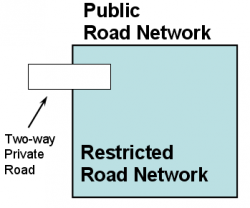
A "Basic Gate" (sometimes referred to as a "Simple Gate") is an access point represented by a single short two-way private road segment.
Basic Gates have a penalty of 1 in both directions.
Basic Gates are often useful for smaller Private Installations, particularly those with just one or a few access points with simple road structures that would make a Standard Gate burdensome to use on the map. Examples include smaller private residential areas with automated gates.
Benefit of this type of gate is that it is more structurally simple than the Standard Gate. Detriments of this type of gate is that it does not allow any road type but "private" to be used and it cannot represent more complex gate geometries often seen at larger Private Installations.
A Basic Gate effectively isolates the entire installation from the public road network unless a route begins or ends within the installation. The private road segments and surrounding roads should be locked with a high enough level lock to prevent novice editors from deleting or changing this control.
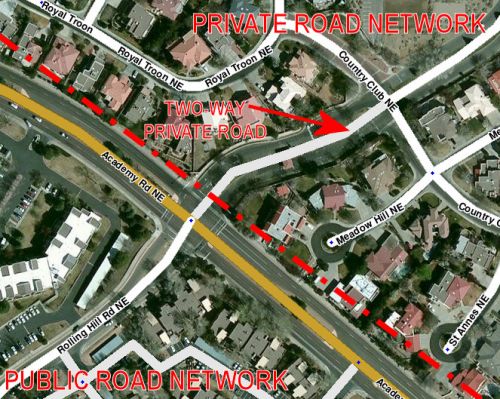
| Warning. Do not mix Basic and Standard gates in the same Private Installation. Doing so will cause incorrect exit routing preferred through the Standard gates. For a solution, see Modified Standard Gate. |
Gate Option: Standard Gate
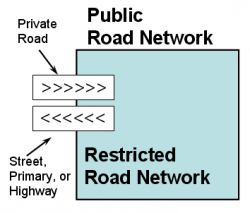
A "Standard Gate" is an access point represented by a one-way split road entering and exiting the installation. The entering one-way road will include one private road segment. The exiting one-way road will be of one segment using the appropriate type of that road (usually street, primary street, or minor highway). This structure often mimics the actual lane geometry for such installations. In addition, exit lanes from private installations are usually not restricted. That is, anyone within the private installation can exit through a gate without credentials or a code to open the gate.
Standard Gates have a penalty of 1 going onto the installation and a penalty of 0 exiting the installation.
Standard Gates are useful for moderate to large-sized Private Installations. This is particularly true where the access points have guard booths, turn around streets, and other structures that would make it hard to use Basic Gates.
A primary benefit of this type of gate is that it can accommodate complex gate road structures such as turn-arounds and wider areas between the entering and exiting roadways. It can also allow the exiting segment to be of the same type as the road network on either side, for example, a primary street. A detriment of this type of gate is that it is more complicated than the Basic Gate.
A Standard Gate effectively isolates the entire installation from the public road network unless a route begins or ends within the installation. All the gate road segments and surrounding roads should be locked with a high enough level lock to prevent novice editors from deleting or changing this control.
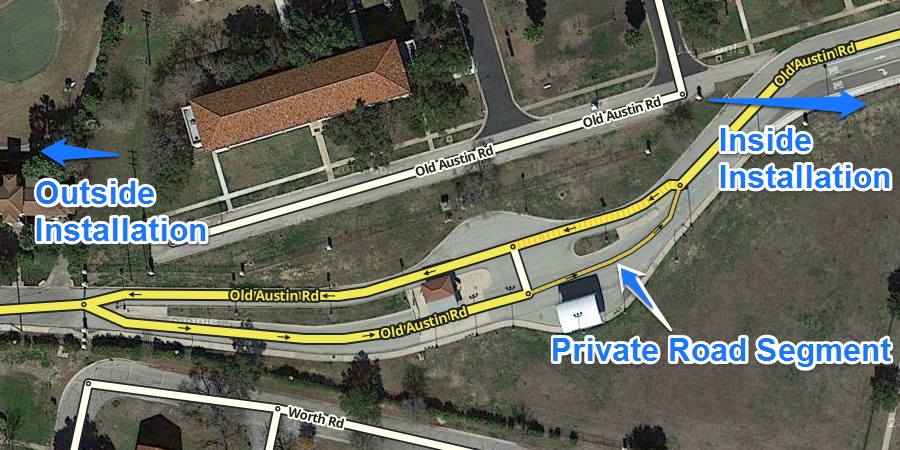

| Warning. Do not mix Basic and Standard gates in the same Private Installation. Doing so will cause incorrect exit routing preferred through the Standard gates. For a solution, see Modified Standard Gate. |
Gate Option: Modified Standard Gate
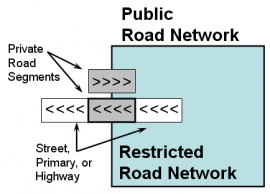
As an advanced topic, one can create a "Modified Standard Gate" that has a different exit road configuration. The exit road would be the standard one-way street, but at least one segment of that path would be private.
Modified Standard Gates have a penalty of 1 going onto the installation and a penalty of 1 exiting the installation.
Why would you use this configuration? Geometry of some gates may require separate entry and exit roads. This makes use of a Basic Gate more difficult because a Basic Gate uses just one two-way segment. The most important reasons is that MODIFIED Standard Gates can be mixed with Basic Gates and still have all gates with the same entrance penalty and exit penalty.
Gate Option: Specialty Gates
This section will consider gates such used to divert very specialty, usually lower-volume traffic at locations including larger military bases and smaller residential communities.
Specialty Gates are those that are usually (but not always) represented with both entry and exit penalty higher than other gates, and thus will never be routed. Instances will be listed here to aid editors in considering their use.
Note that while these gates will never be routed, this is acceptable because they service a much smaller amount of traffic than other resident/visitor gates. Allowing Specialty Gates to have the same penalty as other gates would cause erroneous routes for the majority of traffic. This would result in poor performance for the majority of Wazers.
You may encounter other Specialty Gates, but the ones covered here are:
- Contractor / Deliver Gate
- Restricted Gate
- Resident-only Exit
Specialty Gate: Contractor/Delivery Gate
A "Contractor/Delivery Gate" is one where specialty traffic is routed, primarily on military bases; however, a commercial campus may have an equivalent "delivery entrance" or "construction vehicle entrance" controlled by guards. These gates exist primarily because special inspections or approval must occur for those going to these gates. If this traffic were to be processed at normal gates, the activity would block and delay higher-volume resident/visitor traffic. Standard residents and visitors are usually rejected or turned around at these access points and not allowed to enter or exit at these locations.
Note that those using a Contractor/Delivery Gate may themselves be residents or visitors. They must use this gate for a special purpose.

Note that some Private Installations have a Contractor or Deliver Gate merged with a regular visitor/resident gate. In these cases, use a Basic or Standard Gate. You can recognize these because there is usually a pull-off area where inspections occur for deliveries or large vehicles.
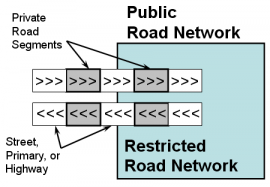
These gates should have a higher penalty than other gates to prevent all entry/exit routing of traffic by Waze. Typically this is done with a private-street-private-street set of segments, or more if required. If possible, use a set of two-way set of road segments. Exact geometry is left to the local editor based upon the structure of the actual roadways. Many options are possible. Make sure to count entry and exit penalties separately and ensure they are at least one larger than other gates.
Specialty Gate: Restricted Gate
A restricted gate is one that has highly restricted traffic flow for residents only. Examples could include a chain link fence closed with a padlock that must be manually opened by residents with a key. The amount of traffic is going to be low because of the manual operation, and therefore this will be a part of Minority Drivers. Editors should not allow routing at these locations because Waze cannot determine which drivers have access and any allowed routing would inconvenience the Majority Drivers.
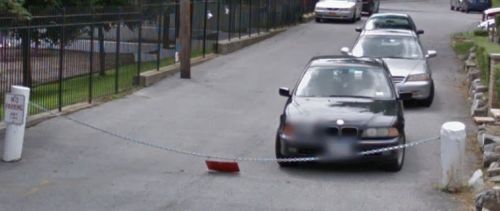
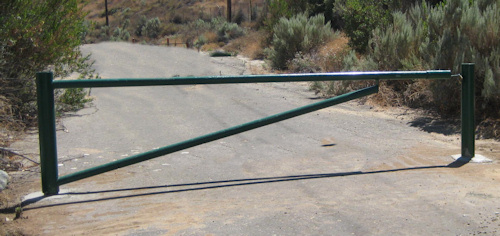
These gates should usually have a higher penalty than other gates to prevent all entry/exit routing of traffic by Waze. Typically this is done with a private-street-private-street set of segments, or more if required. Because traffic can usually go either way once the gate is opened, the preference is to use two-way road segments.
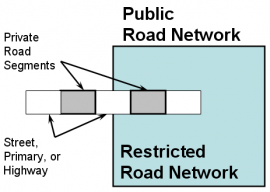
Restricted Gates should have an penalty that prevents routing. Typically this is a penalty of two or more.
An alternative treatment is to use a Blocked Gate rather than a Restricted Gate. We prefer not to do this because a Wazer going through one of these gates would tend to generate a Map Problem Report indicating a road segment was missing.
Another alternate treatment is when a Private Installation is comprised of only restricted gates. In this case, one can model all these gates with Basic gates because they are the same.
Specialty Gate: Resident-Only Exit
Definition: Resident-only exits are those that require a transmitter, a badge swipe, or some form of ID shown to a guard to exit. Visitors are not allowed to exit resident-only exits. Usually this type of gate is used for added security or loss-prevention.
Resident-only exits appear to be fairly rare in Private Installations, but they can exist. Typical Private Installations allow anyone inside to exit without inspection either because guards don't check exiting traffic or a vehicle can pull up to a gate and the gate opens automatically for everyone.
Because Resident-Only exits are rare and usage is likely very local, it is difficult to provide a common approach. It is therefore left to local editor discretion to decide how to handle these gates. Two general options exist. You should pick the one that negatively impacts the fewest drivers.
- Edit an exit penalty equivalent to all regular gates. This will route drivers to this exit based upon Waze algorithms, typically favoring the resident. Visitors routed here will have to find a different exit.
- Edit an exit penalty higher than most gates. This will block these exits from ever being routed. This will favor the unknowing visitor by making sure they are sent to a visitor-friendly gate, but prevent Waze routing algorithms from ever using this exit for residents.
Gate Option: Blocked Gates

A Blocked Gate is an access point that is usually closed. They are opened infrequently by few individuals.
Blocked Gates have an infinite penalty as they cannot be routed.
Blocked Gates exist on small and large Private Installations. A small installation may use a Blocked Gate to allow access to service, repair, or construction vehicles that infrequently visit the installation. Larger Private Installations will likely have more of these Blocked Gates that exist to allow special infrequent traffic.
Blocked Gates might be closed with chains, chain link fences, various types of gate structures that can open and close, and even concrete barriers. They might be used very infrequently or daily by a small set of residents.
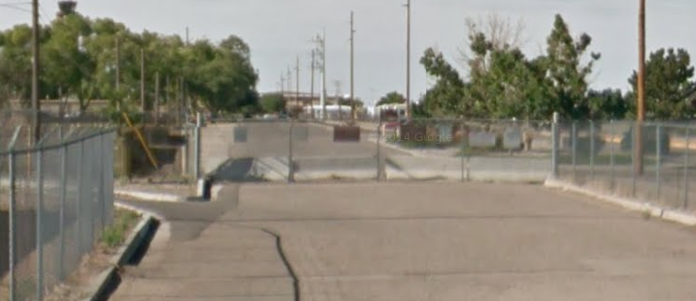

Because these access points are usually closed, we will represent them on the Waze Map as disconnected road segments that permanently disallow traffic flow. It is not worth trying to allow the infrequent traffic that would move through these gates because we have no way of knowing when they would be open. Inconvenience to the majority of Wazers could be extreme.
The surrounding segments should be locked at a rank high enough to prevent lower-level editors from reconnecting the road.
Blocked Gates can be used as needed in any Simple or Complex Installation without restriction because they disallow all traffic at all times.

Editing Approach - Simple/Complex
If you are familiar with editing Private Installations, this section is not required. it is included here to provide advice and suggestions to those new to Private Installations.
Because there are so many different types and variations of Private Installations, we organize them here in two categories - how they might be approached by editors. The two categories and their characteristics are:
- Simple Private Installations
- Contain one type of gate at one or more access points.
- Penalties for all entry pathways are the same.
- Penalties for all exit pathways are the same.
- Primary editing focus is to prevent the public from routing through the Private Installation.
- Are fairly easy to edit.
- Complex Private Installations
- Contain two or more types of gates at multiple access points.
- Resident-only gate
- Visitor/Resident gate
- Specialty gate (such as contractor gate, restricted gate, etc.)
- Penalties for entry pathways may not be the same.
- Penalties for exit pathways may not be the same.
- Strong potential for inaccurate routing if gates are not configured properly.
- Likely no perfect solution for all types of drivers (Resident, Visitor, Special-purpose)
- Contain two or more types of gates at multiple access points.
Common Best Practices
- Do not disconnect roads to alter routing into Private Installations because this does not reflect reality in the road system, impacts residents that can enter any gate, and stops people from routing out of the Private Installation. The only time this is done is when the road is really closed all or most of the time. See the section on Locked Gates.
- Do not make all roads within a Private Installation "private roads." This does not reflect reality, has been found to cause routing errors in Waze, prevents use of a diverse set of gate types, and prevents nested Private Installations. Because this was an accepted practice in the past, you may need to alter prior work like this.
- Test your Private Installation. Test in Live Map. If possible, drive-test your Private Installation or seek help from a local resident. Information about testing your editing is contained elsewhere on this page. Such testing can help you find rogue connections and errors in gate treatment on the map.
Editing Simple Private Installations
This section explains how to edit Simple Private Installations.
Definition - Simple Private Installations
Simple installations are those private communities, military bases, and other installations with only one type of gate treatment for one or more access points. Access points may include only one of the following and as many Blocked gates as needed:
- Basic Gates
- Standard Gates
Typically these attributes might indicate an installation is Simple: (a) only one access point, (b) for multiple access points all gates are the same. The size of the Private Installation does not matter. The largest Private Installation in the USA, White Sands, is a Simple Private Installation.
The editor's primary focus is to prevent the public from routing through the Private Installation. Secondary focus is to have all exit penalites the same and all entry penalties the same so that Waze routes users based upon nearest gate and traffic conditions.
Examples
- Small gated/private community
- Gated country club with smaller area
- Private school
- Small closed commercial campus
- Simple Military sites (e.g., National Guard armories), usually those without Specialty Gates.
This does not include paid parking lots and other parking facilities. These are to be mapped with parking lot roads. See the Special Rules section below.
Simple Installations: Preferred Editing Approach
Every access point must be of the same type of gate, either all Basic or all Standard. One cannot use a mixture of these two gates because routing out of the Private Installation would always favor Standard gates no matter where the driver was located.
It is suggested that you separately count the penalties at each gate for exiting and entering. For the Private Installation to route properly, (1) All entry penalties should be the same for every access point or gate and (2) all exit penalties should be the same for every access point or gate.
Blocked Gates are always allowed editing a Simple Installation because they do not alter routing behavior.
By definition, other gate types, like Specialty gates, are not defined for a Simple Installation. This would make it a Complex Installation.
Note that it is permissible to use Basic Gates at locations where guard houses are located if the entry and exit roads are one and the same or very close together.
Area Places
Because visitors may be routed to resident-only gates in this approach, editors should consider placing a sufficiently large Area Place over each visitor gate and naming it. In this way a visitor would have the option of routing to the appropriate gate (via the Area Place) to which their host directs them or they otherwise know to travel.
Editing Complex Private Installations
This section explains how to edit Complex Private Installations.
Definition: Complex Private Installations
Complex Installations are those private communities, military bases, or other installations that have more than one gate treatment for multiple access points. Access points in the installation may include one or more of the following:
- Basic Gates
- Standard Gates
- Specialty Gates
- Blocked Gates
Complex Installations may have other key attributes. They large enough that there is some reason to have primary streets or highways. They are also more likely to have multiple levels of access control (installations within installations). Specifying exact size is not effective because of significant variation in these installations.
Typically these attributes might indicate an installation is large: (a) more than 20-30 roads, (b) secondary roads or highway streets needed.
Moderate sized installations between "smaller" and "larger" will exist and discretion of the local editor should be considered.
The editor's focus is (A) to prevent the public from routing through the Private Installation, (B) ensure basic accurate routing for the majority of drivers, and (C) decide how to handle different routing for residents, visitors, and special-purpose drivers.
Examples:
- Larger Military base
- Larger Government sites
- Huge hunting lodge and hunting grounds, ranches, etc.
- Large closed commercial campus
- Large country club or private communities with multiple entrances
Private installations covered by this article do not include airports or theme parks. See the "Special Rules" section of this wiki page for information concerning roads in these locations.
Complex Installations: Preferred Editing Approach
It is recommended that, just like Simple Installations, most access points be of the same type of gate, either all Basic or all Standard; however, other gate types can be added if they produce the desired routing behavior. Typically delivery and contractor gates (Specialty gates) should have an entry and exit penalty one higher than all other gates so that no resident or regular visitor is routed in or out of these gates. This is because traffic volume using delivery and contractor gates is very small.
Blocked Gates are always allowed editing a Complex Installation because they do not alter routing behavior.
One approach to consider is this:
- Use Blocked gates for all those gates permanently or semi-permanently closed.
- Use a Simple Installation approach at first so all remaining gates are routed equally.
- Identify contractor or delivery gates. Using Specialty gates, make sure that the entry and exit penalties of these gates is at least one higher than all other gates so they are never routed.
Special Topics: Larger Private Installations
Public Roads Across Private Installations
Many larger military bases and perhaps other private installations sometimes have long right-of-way permissions for a publicly accessible road, often times this is a highway or primary street. (e.g., US-70 through White Sands Missile Range.) These highways run across the private installation with no restriction to traffic but provide no access to the installation itself. Editors should not create any access restrictions in these regions. Because these roads are often times fenced off on both sides from the private installation, editors should be on the look out for private installation roads inappropriately connected to the public road. These are usually locked off by gates most of the time, in which case the road can be disconnected or have a gap. Some of these are entry/exit gates with treatments noted above.
Preventing Other Editors from Making Mistakes
One method of preventing mistakes from novice editors has already been discussed, locking of the private road segments and surrounding segments. There is another approach that may be valuable.
Larger private installations, such as a military base, that are embedded in a city often have legacy roads that used to connect to the public road network. From the Waze Editor aerial images, it can look like these roads actually connect to the private installation, when upon closer inspection (if possible) there is really a fence that permanently blocks the road. There may also be a fence gate that is closed most of the time, only opened when guards are present. In both these situations, there should be no road connection, or a gap in the road network within the Waze Editor.
Novice editors or experienced editors that are not paying attention, may accidentally connect these roads when they should not be connected. A map comment should be placed at the fence or gate to notify editors that it is permanently blocked by fence/gate. These segments and the map comment should be locked at Rank 5 to prevent connection in error.
Gate Closures and Restrictions
Many larger installations will have access/entry points or gates that have limited hours or that are closed on certain holidays. Utilize Scheduled Restrictions in the editor to allow Waze to know when to route through a particular gate. These are typically not turn restrictions, but restrictions on traversing a segment. Some gates can be very isolated on larger installations so routing may navigate someone 10 to 30 minutes to a closed gate.
When doing this, enable Scheduled Restrictions for only one segment in each direction to reduce editing errors and maintenance. This segment should be the private road segment on the inbound direction (or the single two-way private segment). For entry points with a one-way outbound regular road type, it should be the segment adjacent to the private inbound segment. Scheduled restrictions would usually be the same on these two segments unless the private installation has differing entry and exit policy.
You can find the hours of gates or entry points through the private installation website or by calling the appropriate private installation authority.
Area Places for Access/Entry Points
Entry points for larger government Private Installations are typically named such as "North Gate" or "Maxwell Gate." These are Area Places that are useful for those using Waze to understand their location relative to the Access Point. It is suggested an Area Place of type "Professional and public" then "Government" be generated over the larger region of the Access Point and named with the short name of that Access Point. Do not make the Area Place just the size of the guard houses or other features. Make it large enough to encompass the area so that it is easily seen on the Waze client.
If you do not know the name of the Access Point for government Private Installations, do not create an Area Place. Names of Access Points may be known locally or found on on a website about the private installation.
Because visitors to residential Private Installations may be routed to resident-only gates in the preferred approaches, editors should consider placing a sufficiently large Area Place over each visitor gate and naming it. In this way a visitor would have the option of routing to the appropriate gate (via the Area Place) to which their host directs them or they otherwise know to travel.
Additional information about Places is in the Special Rules section.
Installations with Special Rules
These "installations" are called out for special rules because they are similar to private installations but are handled differently than guidance on this wiki page.
Paid Parking Lots
Most drivers to these facilities are "visitors." There is usually no strict access control other than penalty for not paying or obtaining some kind of entry ticket. Control is often exercised at exits where drivers must pay.
Paid parking lots and other parking facilities are to be mapped with parking lot roads, and not according to the Private Installation rules defined in this article. See Best map editing practice#Parking Lots.
Airports: Rental Car Lots
Airport Rental Car Lots have different type of access control but are very similar to Paid Parking Lots. There is usually no entry access control, but there is exit access control.
Rental car lots and other parking facilities are to be mapped with parking lot roads, and not according to the Private Installation rules defined in this article. See Best map editing practice#Parking Lots.
Airports: Air-side Roads
Most drivers to these facilities are "visitors."
Do not map the private, restricted-access roads on airport grounds at all. Map airport roads which are accessible to the public (terminal pick-up/drop-off roads, parking lot access roads, etc.) as public roads, not as private installations.
Airports have "air-side" restricted road networks that allow traffic for baggage carts, service vehicles, airplane fuel tankers, etc. While it may be tempting to map this road network either as an isolated set of roads or with provisions cited elsewhere in this document for Private Installations, this should not be done. Here's why:
- A large number of people use Waze to navigate to airports. The particular search service or function that returns a GPS coordinate to Waze may be in error, placing the destination marker nearer to the air-side private road network of the airport than to the public airport roads. This could lead to an incorrect route or even an impossible-to-reach destination, which would frustrate the traveler.
- The private air-side road network of an airport tends to be both close to and accessible from the public road networks around the airport and therefore is more prone to this navigation error.
- Very few people use the private road network of an airport, relative to the great number that use an airport's public access roads. To those that have requested this function, we apologize. The benefit of doing this for few would likely inconvenience many. We suggest routing to the nearest spot to your destination (i.e., the gate) on the public road network.
In some cases, military bases hold public airports. In such situations, some discretion and creativity may be needed to decide which roads on the airport should not be mapped and which on the military base should be mapped. Usually there is a second perimeter around the airport separating it from the base.
Theme Parks
Most drivers to these facilities are "visitors." While many parking lots are accessible by anyone, some require payment to enter. For very large Theme Parks like those around Orlando, some access roads may be used by locals as well as visitors and therefore should not be private.
Publicly accessible roads in a theme park, even after a pay-station/gate, are to be mapped with parking lot roads, similarly to other paid parking lots. Furthermore, be careful with mapping the "backstage" private roads which are only to be used by employees. It may be wise to not map these roads, similarly to "air-side" airport roads as described in "Airports" (but to a lesser extent), so that routes are given to the public entrance of the theme park facility.
Military Bases and Government Installations
See Military Bases for proper editing on a military base.